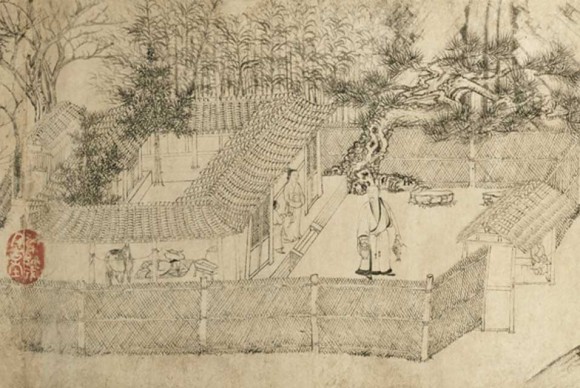Rotation at The Nelson-Atkins Museum of Art Features Seminal Chinese Painting
KANSAS CITY, MO.- A rare Chinese scroll by Qiao Zhongchang is part of the current rotation of Chinese and Japanese paintings at The Nelson-Atkins Museum of Art, Expressions of Brush and Ink: Literati and Chan (Zen) Painting in China and Japan. The exhibition offers 23 paintings including Qiao Zhongchang’s Illustration to the Second Prose Poem on the Red Cliff , considered of seminal importance in the history of Chinese painting. The hand scroll, which dates from the 11th to early 12th century, has not been on view at the Museum for 10 years. Its acquisition was announced at the beginning of the Museum’s 50th anniversary in 1983. The Museum is currently celebrating its 75th Anniversary with a capstone exhibition of gifts of art, Magnificent Gifts for the 75th.
Sixteen of the paintings in the Chinese and Japanese painting exhibition were acquired during the 39-year Museum career of Marc F. Wilson, who became the Menefee D. and Mary Louise Blackwell Director/CEO in 1982.

Qiao Zhongchang, Chinese (act. Late 11th-early 12th century). Detail, Illustration to the Second Prose Poem on the Red Cliff, 11th century-early 12th century. Hand scroll, ink on paper. Purchase: Nelson Gallery Foundation, F80-5
When the 1983 acquisition of the Red Cliff scroll was announced, Wilson said of the work: “If I acquired no other Chinese painting in my entire career, I could still be happy that I acquired this.” Today, he stands by the statement and reflects: “The Red Cliff is not easy to understand immediately in visual terms, but the payoff when you finally do get it is mind boggling. It is an exceptional work of art that is conceptually so beyond anything else of its kind that it is beyond classification concepts of ‘good, better, best.’”
Red Cliff was the site of a decisive battle in 208/9 at the end of the Han dynasty prior to the beginning of the Three Kingdoms. It has become a major tourist attraction southwest of present day Wuhan on the Yangtze River in southern China. The battle was the subject of a two-part movie, Red Cliff, released in 2008 and 2009. The Nelson-Atkins’ 18-foot-long scroll depicts the story of the poet Su Shih entertaining friends in the area some 900 years after that battle.
The Museum’s Red Cliff hand scroll is the earliest and finest surviving example of a new and revolutionary approach to painting. It encapsulates the provocative idea promoted by a group of highly educated painters during the late 11th and early 12th centuries that painting was no longer exclusively or even primarily about realism, but should consciously express the intellectual beliefs and artistic personality of the painter. This notion not only changed the course of Chinese painting and art criticism, but was also the first time in the history of art that artistic personality was so explicitly emphasized.
The exhibition Expressions of Brush and Ink, which explores the use of brushwork in Chinese and Japanese ink paintings, was curated by Ling-en Lu, Assistant Curator of Chinese Art, with assistance from Colin MacKenzie, Senior Curator of Chinese Art.
“Brushwork was much more than a descriptive device for these artists. It was a vehicle by which painters expressed their artistic personality,” Lu said. “The exhibition contains many examples of varied styles of brushwork and their artistic effects.”
Taigu Yimin’s Traveling Among Streams and Mountains was painted in the 13th century when North China was under foreign domination and suggests a nostalgic vision of a harmonious never-never land in which the artist could find a spiritual sanctuary.
Hon’ami Koetsu’s Nine poems from the Shui wakashu uses a graceful cursive calligraphy that evokes the court style of the time in Japan: soft, pliant and flowing ink brushstrokes written on a paper printed with opulent floral designs.
Gong Xian’s 30-foot long Landscape in the Manner of Dong Yuan, painted in the 17th century, anticipates the pointillist style of French impressionists in its use of layered strokes
and dots to construct forms, but brushed purely in shades of monochromatic ink, produces a much more somber and melancholic vision of the world.
A gift from Wilson and his wife, Elizabeth, is also on view, Chan (Zen) Wisdom by Jian Zhaoshen who was a former vice-director at the National Palace Museum in Taiwan and modern literati painter. It consists of two Chinese characters: Chan and Hui, meaning wisdom of Chan (Zen).
The Rotation will be available for view through Aug. 8.
Related posts:
- Rare Opportunity to View Seminal Event in the History of Chinese Painting
- Abelardo Morell to Give Lecture at The Nelson-Atkins Museum of Art
- Torn Pieces of Ancient Chinese Painting Reunited at Taiwan National Palace Museum
- Contemporary Works in Clay from Kansas City Collection Featured in Exhibition at The Nelson-Atkins
- Nelson-Atkins Museum of Art retains three scumak sculptures by Roxy Paine
